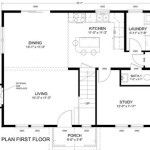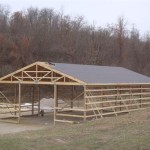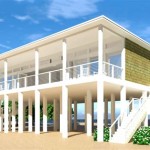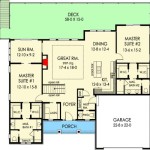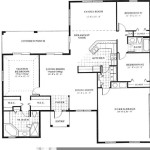Handicap House Plans: Designing for Accessibility and Inclusion
Designing a home that caters to individuals with disabilities requires careful consideration of various factors, aiming to create a safe, comfortable, and independent living environment. Handicap house plans, also known as accessible house plans or universal design house plans, prioritize features that accommodate mobility limitations, visual impairments, and other special needs. These plans extend beyond simple compliance with accessibility codes; they focus on creating a functional and enjoyable living space for everyone, regardless of their physical abilities.
The core principle behind handicap house plans is universal design, which strives to create products and environments that are usable by all people, to the greatest extent possible, without the need for adaptation or specialized design. This approach benefits not only individuals with disabilities but also aging individuals, families with young children, and anyone seeking a more user-friendly home. By incorporating universal design principles, architects and designers can create homes that are not only accessible but also more convenient and comfortable for all occupants.
Effective handicap house plans address a wide range of needs, including wheelchair accessibility, ease of navigation, and adaptability to changing needs over time. Key elements include wider doorways and hallways, ramps and elevators, accessible bathrooms and kitchens, and adaptable storage solutions. The goal is to minimize physical barriers and maximize independence, allowing individuals with disabilities to live full and active lives in their own homes.
Different types of disabilities will require different considerations and modifications. For example, a person with limited mobility will need a level entry, wider doorways, and roll-in showers, while a person with a visual impairment will benefit from clear and consistent lighting, contrasting colors, and tactile cues.
The following sections will delve into specific aspects of handicap house plans, exploring key design considerations, essential features, and practical examples to illustrate how accessibility can be seamlessly integrated into home design.
Essential Accessibility Features in Handicap House Plans
Designing for accessibility involves more than just meeting minimum code requirements. It's about creating a home that is truly functional and comfortable for individuals with disabilities. Several key features are critical in achieving this goal.
*
Entryways:
The primary entrance to the home should be accessible to individuals using wheelchairs or other mobility devices. This typically involves a ramp with a gentle slope (ideally 1:12 ratio, meaning for every inch of rise, there are 12 inches of run) or a zero-step entry. Doorways should be at least 36 inches wide to accommodate wheelchairs and walkers. Thresholds should be low or non-existent to prevent tripping hazards.*
Hallways:
Hallways should be sufficiently wide to allow for easy maneuvering of wheelchairs and other mobility devices. A minimum width of 42 inches is generally recommended. Clear turning spaces should be provided at intersections and dead ends.*
Doorways:
Interior doorways should also be at least 36 inches wide to ensure accessibility throughout the home. Lever-style door handles are easier to operate than knobs, especially for individuals with arthritis or limited hand strength. Pocket doors can be a space-saving option and eliminate the need for swing space.*
Flooring:
Smooth, non-slip flooring is essential for accessibility. Avoid carpets with thick padding or high pile, as these can impede wheelchair movement. Hardwood, laminate, tile, and low-pile carpets are good choices. Ensure that transitions between different types of flooring are smooth and level to prevent tripping hazards.*
Lighting:
Adequate lighting is crucial for safety and visibility. Use a combination of ambient, task, and accent lighting to illuminate all areas of the home. Consider using dimmer switches to allow for adjustable light levels. For individuals with visual impairments, contrasting colors can help to improve visibility and orientation. Motion-activated lighting can also be a useful feature for hallways and entryways.*
Electrical Outlets and Switches:
Position electrical outlets and switches at accessible heights. Outlets should be located at least 15 inches above the floor, and switches should be located no more than 48 inches above the floor. This allows individuals using wheelchairs to easily reach and operate them.The integration of these features contributes significantly to the usability and comfort of the home for individuals with disabilities, facilitating independent living and enhancing their overall quality of life.
Accessible Bathroom Design Considerations
The bathroom is often one of the most challenging spaces to navigate for individuals with disabilities. Careful planning and attention to detail are essential to create a safe and functional bathroom.
*
Roll-in Showers:
Roll-in showers eliminate the need to step over a threshold, making them accessible to individuals using wheelchairs or other mobility devices. The shower should be large enough to accommodate a wheelchair and allow for maneuvering. Install a handheld showerhead and a fold-down seat for added comfort and convenience. Grab bars should be securely mounted at strategic locations in the shower.*
Toilet:
The toilet should be located in an accessible area with sufficient space for transfers. Install grab bars on either side of the toilet to provide support and stability. The toilet seat height should be between 17 and 19 inches to make it easier to sit down and stand up.*
Sink:
The sink should be mounted at a height that is accessible to individuals using wheelchairs. The countertop should be shallow enough to allow for knee clearance. Insulate the drainpipes to prevent burns. Lever-style faucets are easier to operate than traditional knobs.*
Flooring:
Use non-slip flooring in the bathroom to prevent falls. Avoid rugs or mats that can create tripping hazards.*
Vanity:
The space underneath the vanity should be open to allow wheelchair users access to the sink. If storage is required, consider pull-out drawers or shelves.*
Mirrors:
Install a mirror that is angled downwards to allow individuals using wheelchairs to see themselves. Alternatively, consider using a tilting mirror.Meeting these specifications can help provide an accessible and comfortable bathroom environment for individuals with disabilities.
Kitchen Design for Accessibility
The kitchen is another area that requires careful consideration in handicap house plans. The goal is to create a functional and safe space that allows individuals with disabilities to prepare meals and participate in kitchen activities independently. Planning for the correct counter heights, appliance placement, and storage solutions is essential.
*
Countertops:
Install countertops at varying heights to accommodate different needs and preferences. A lower countertop (around 30 inches) is suitable for individuals using wheelchairs. A higher countertop (around 36 inches) is comfortable for standing users. Adjustable-height countertops are also available.*
Sink:
The sink should be mounted at a height that is accessible to individuals using wheelchairs. The countertop should be shallow enough to allow for knee clearance. Insulate the drainpipes to prevent burns. A single-lever faucet is recommended for easy operation.*
Appliances:
Choose appliances with accessible controls and features. Side-by-side refrigerators are easier to access than top-freezer models. Front-control stoves and ovens are safer and more convenient than rear-control models. Consider using a dishwasher with a pull-out rack for easier loading and unloading.*
Storage:
Optimize storage space with pull-out shelves, lazy Susans, and adjustable-height cabinets. Store frequently used items within easy reach. Install a pull-down shelving system for upper cabinets to make them more accessible.*
Work Triangle:
Design the kitchen with an efficient work triangle, connecting the sink, stove, and refrigerator. Ensure that there is ample space for maneuvering around these key areas.*
Flooring:
Use non-slip flooring in the kitchen to prevent falls. Avoid rugs or mats that can create tripping hazards.By incorporating these design principles, kitchens can become more user-friendly and allow individuals with disabilities to enjoy cooking and socializing in a safe and comfortable environment. These considerations are crucial for the creation of effective handicap home plans.

Accessible Handicap House Plans Style Results Page 1

Wheelchair Accessible Small House Plans Drummond

Wheelchair Accessible Floor Plan House Plans

Exclusive Wheelchair Accessible Cottage House Plan 871006nst Architectural Designs Plans

Plan 8423jh Handicapped Accessible Split Bedroom Southern House Plans Floor

Wheelchair Accessible House Plan 2 Bedrms Baths 1687 Sq Ft 147 1009

Plan 1658 Handicapped Accessible House

Plan 062h 0012 The House

Attractive Traditional House Plan With Handicapped Accessible Features 86279hh Architectural Designs Plans

Goodman Handicap Accessible Home Plan 015d 0008 Search House Plans And More


